Black Cat Club
The Black Cat was a legendary night club located on the corner of Bloomington Road and Cedar Ave. in Bloomington. Those roads became Old Shakopee Road and Old Cedar Ave., and its address became 9139 Cedar.
Stan Danielson explains that this was originally a house on the SW corner of the intersection for some years before Jeremiah Scott bought it in the early 1900s and moved it to the NE corner. He called this intersection, “Long Meadow.”
The photo below shows a precursor to the Black Cat – Scott’s Long Meadow, where you could get Minnehaha Pale. This near beer was made by the Golden Grain Juice Company, and was a malt beverage with no more than 0.5 percent of alcohol. The photo has been tentatively dated to 1915-1916, which was before Prohibition, but Bloomington may have been dry at the time.
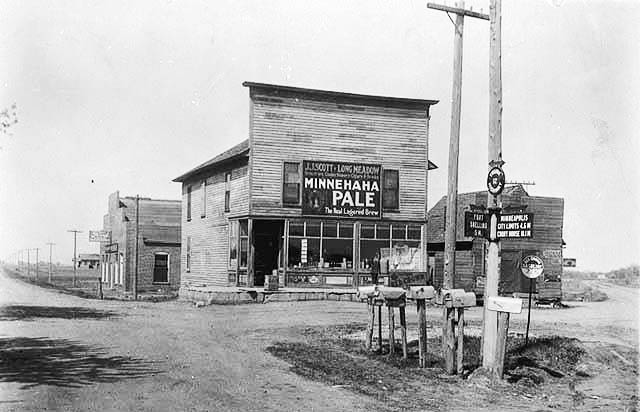
Photo courtesy Minnesota Historical Society
To the left of the building in the photo above was Scott Ford, a car dealership that dates back to the early 1900s. According to Greg Rohlen, that building still stands on the east side of Cedar at 91stStreet.
Based on the photo above, Kirk Brust created the painting below in the late 1990s. He sold the painting, but kept a photo of it to share on Facebook, and has given me permission to post it here. Thanks, Kirk!
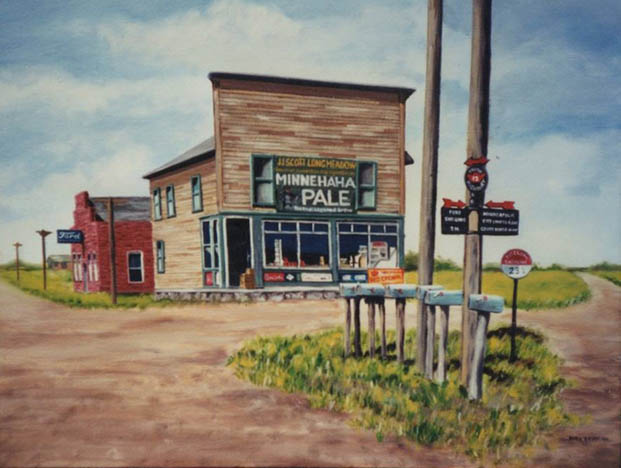
Courtesy of Kirk Brust
THE BLACK CAT
If anything, the owners were good at publicity! I have a LOT of ads to post here, so bear with me.
Here is what appears to be the second ad in the Minneapolis newspapers. It promised paved roads from town, room for 250 cars, the music of George Barton and his “peppy” Chat Noir (French for Black Cat) Orchestra.
Fine food was prepared by Adolph Berger, a man who was obviously German but who had been cheffing here in Minnesota safely since 1913, before World War I. 1929 was still during Prohibition, but out in the sticks of rural Bloomington, all bets were probably off, and that Near Beer was no doubt a thing of the past.
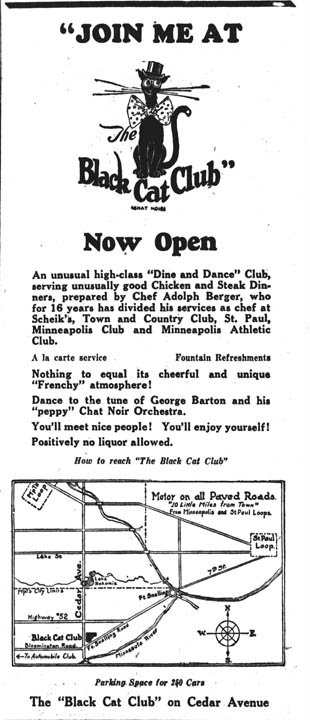
July 20, 1929
The Black Cat looks like he’s dancing and having a good time!
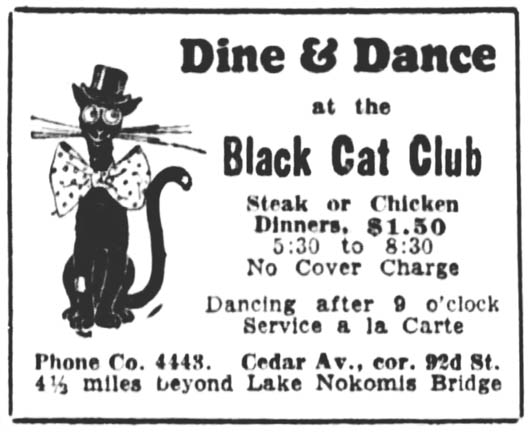
Minneapolis Star, August 15, 1929
Music by Bill Moore and his Nine Dixie Playmates. Moore was extremely popular in the 1920s and ’30s, with an ever-changing lineup of musicians. The cat looks a little more threatening – or threatened.
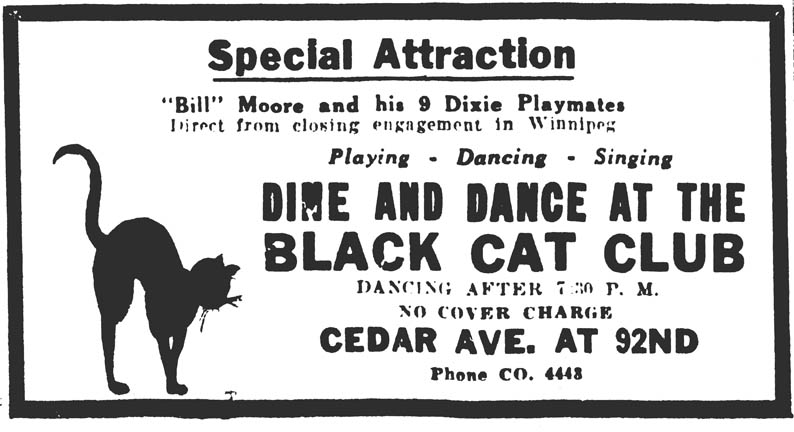
By November 1929, radio station WDGY was broadcasting the Black Cat Club Orchestra from 6 to 6:45 pm. Another program was the “Whoopie!” Club.
In 1930, WCCO Radio did a broadcast that simulated a visit to the Chat Noire, a Paris nightclub that dates back to 1881. French songs would be sung at the Black Cat, if I’m reading this right, over a series of programs. (Minneapolis Tribune, February 16, 1930)
CEDAR CREST
At approximately June 2, 1930, the name of the establishment became Cedar Crest. The house band continued to be broadcast over WDGY as the Cedar Crest Orchestra. The manager was J.B. Waite.
On August 23, 1930, Waite was arrested in a raid that found 15 couples still dancing after the midnight curfew. No dancing on Sunday! (Minneapolis Star, August 25, 1930) Waite was convicted and fined $25, but argued that his was a night club and not a public dance hall, and would appeal.
On June 11, 1932, Art Bowee, identified as the operator of the Cedar Crest, was arrested for allowing dancing after midnight on a Saturday night. He plead not guilty. (Minneapolis Star, June 15, 1932) On August 25, the Tribune identified said proprietor as Arthur Bubee, and said that the $100 fine levied upon him for allowing five couples to dance after midnight had been dismissed upon appeal, because the couples had not paid anything to dance.
On September 24, 1933, the Cedar Crest was advertised for sale. It also had “five modern living-rooms on second floor.”
The last ad found for the Cedar Crest was December 30, 1933.
FLYING HOME
At the time the Black Cat was established at the turn of the 20th Century, there were plenty of open spaces in the nascent Bloomington, enough for a small private flying field at 87th and Cedar. Pilots and their passengers would take advantage of the remoteness of the place and indulge in activities that were more closely watched in the Twin Cities of Minneapolis and St. Paul.
Instead of Near Beer, patrons could get 3.2 beer before Prohibition was over in 1933. If they wanted something stronger, that could be had under the table.
In a Sun Newspaper article by Harvey T. Rockwood that was published in anticipation of the building’s demolition, material from the book Minnesota Aviation History 1905-1945 by Noel Allard was quoted. I’ll repeat it here.
The area around Cedar airport was generally planted in grain crops except for the runways. A heavily wooded area bordered the field to the north, along Cedar Avenue. Not far from the southern end of the airport, on the northeast corner of the Road, was another of the legendary watering holes favored by local flyers, the Black Cat Club. Stories of its parties and girls are prevalent among the nostalgia set.
If the men wanted someone of the weaker sex, that could be had upstairs on the second floor. Lots of rumors flew about the Black Cat being a house of prostitution, although no one seems to be willing to admit to experiencing it first hand.
Some comments on Facebook:
- My mom and dad went there in the 1930s and ’40s…they said it was way out in the country then. Mom always said it was the “Dirty Pussy” and someday I will tell you why.
- In the early 1960s my parents and other neighbors called it the “Dirty Kitty!”
ABOUT THE CAT
Benjamin Pahl shared this black cat story on Facebook:
My grandma and grandpa owned a farm on 90th and Cedar. Their names were Nicholas and Mary Pahl. It was during the War years and I was just a little boy. My dad was in the service but at home at the time. He built a basement house on grandma’s farm on 90th St. It had block walls in the ground and it was capped with tarpaper on top. The house was to be finished at a later date.
I went to the Black Cat with my dad and they had a black panther chained to a pole in the bar. I was told to steer clear of the cat as it was dangerous. One night we had just gotten into bed and we heard a four-legged animal running around on top of our roof . The neighbors passed the word that the black cat was on the loose so we kind of knew what was on the roof. My dad went up to see what it was, and sure enough, it turned out to be the Panther. He called the constable, who was our cousin, Virgil Pahl. Virgil told us to stay in the house, as he was on the way. They found the cat at the old Cedar Airport next to my grandma’s house. A short time later we heard a gunshot. They had to shoot the cat. True story.
THE SPENCERS
From at least 1934 to 1941, Alwin and Rose Spencer were the owners of the Black Cat.
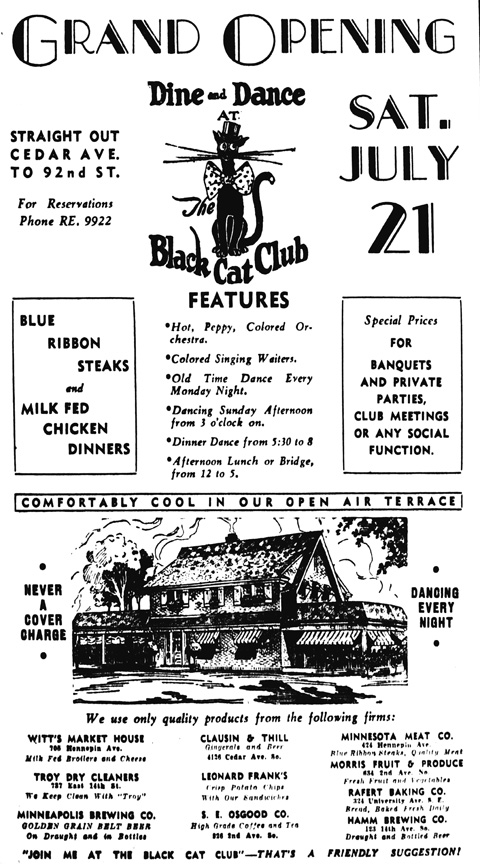
July 21, 1934
Now the ad above is intriguing in a few ways. First, it’s the Grand Opening – perhaps it should be the Grand Re-Opening, since it lost its wonderful name from 1930 to 1933. This is no doubt when the Spencers bought and re-opened the Club. We do know that they owned it by September 16, 1934, from a mention in a column (“Peg About College” in the Minneapolis Tribune). That paragraph calls the “ultra attractive” Chat Noire room “the Twin Cities most beautiful and exclusive suburban restaurant.”
Then there’s the music: “Hot, Peppy, Colored Orchestra,” and “Colored Singing Waiters.” Bill Moore’s many-iterated orchestras were “colored,” that’s for sure.
The last thing is that they provided a sketch of the place, which looks very much like a 1939 photo that Rick Spencer, Al and Rose’s grandson, posted on Facebook. I blew up the 1934 sketch, and I’ll follow it with Rick’s picture.
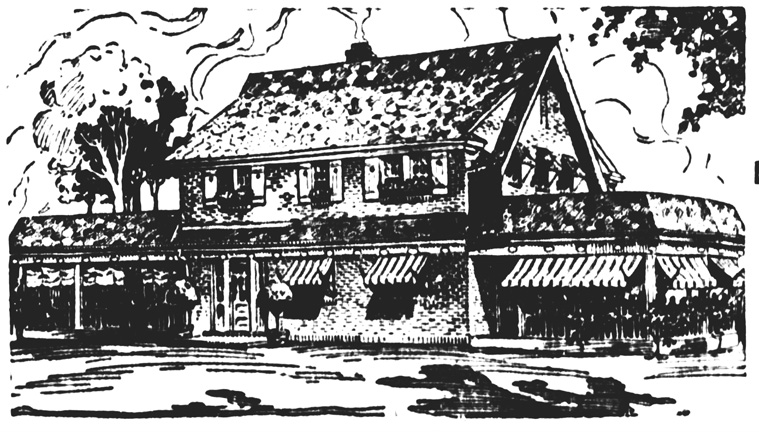
July 21, 1934
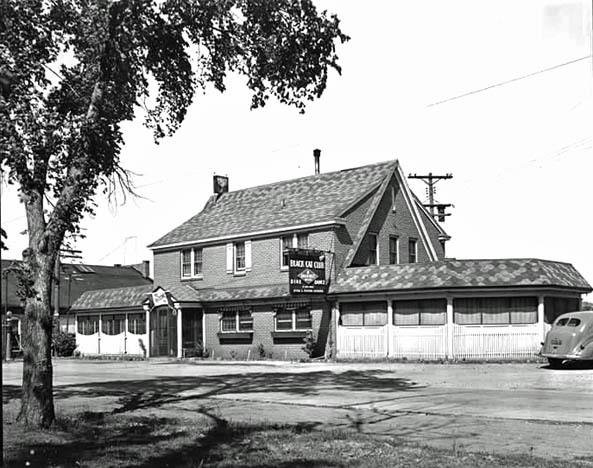
1939 Photo courtesy Rick Spencer
SLEIGH RIDES
A 1936 Valentine’s Day idea floated in the Minneapolis paper was a “Pay Party” – a new New York way of saying Dutch Treat. “Make yours an old time sleigh ride party at The Black Cat Club – $1.00 per person includes sleigh, food and dancing.
These sleigh rides were very popular, especially with fraternities and sororities.
CHANGE OF OWNERSHIP
On April 6, 1941, we find this ad in the Classifieds:
NITE CLUB – Colonial bldg & equipment. All mod liv quarters. Owner has other interest. Take city property in trade. The Black Cat Club, 92nd & Cedar.
An item in the Minneapolis paper dated April 10, 1943, says that Al, formerly with the Black Cat and Cobblecrest Gardens, was now the manager of Jerry Gerow’s President cafe “out across from the ball park. Al’s meeting meat rationing with a trick method of preparing jumbo frog legs. They’re the talk of the section already.”
MELODY INN
Another name change came and went – I can only pin it down to between December 1945 and December 1946. This is the only ad found. The 1946 date comes from a classified about a lost watch.
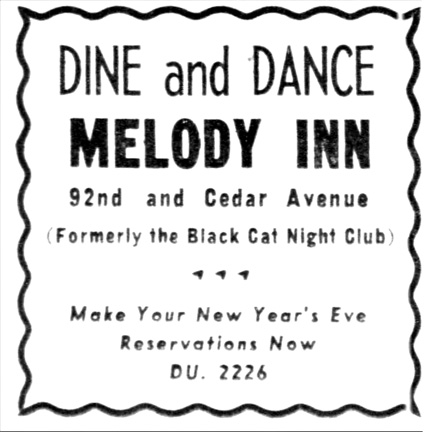
Minneapolis Tribune, December 23, 1945
AND THE CAT COMES BACK
As is often the case, we learn things from crime reports. In this case, we know that the place was back to the Black Cat by January 1, 1951, when two Minneapolis men entered the Black Cat with the stated intent of selling flowers. I instead they accidentally sold a fifth of whisky to an undercover off-duty constable. Trouble ensued.
In May 1954, Otto G. Arnold, President of the Sanitary Sausage Company, was in trouble with the IRS for unpaid taxes. Some of those taxes had to do with unreported dividends from the Black Cat Club, where he claimed “bad debt” that the IRS contended was unsubstantiated. Shortly afterwards, in June 1954, the owner was trying to rent out the club and the kitchen.
One of the last mentions of the Black Cat in the newspaper is a tragic one. On December 11, 1959, 66-year-old Raymond Love of Clarkfield, Minnesota, choked to death on a piece of steak. Love had been at a wrestling match in Minneapolis with his son-in-law, and stopped at the Black Cat for a bite on the way home.
And the last mention found in a search of the Strib is a Lion’s Club meeting held on April 20, 1960.
NICHOLS SUPPER CLUB
A search for the address of the Black Cat brings up the Nichols Supper Club, which first advertised for a cook on December 28, 1961. Those ads continued until January 2, 1962.
THE CAT IS BACK
But wait! Some 1961 State law required bars to apply for liquor licenses, and the Black Cat applied for one in May 1963. Apparently they were successful, because they were advertising for waitresses a week later. Was it all over on March 1, 1964? Methinks the poor old cat, now 35 years old (how old is that in cat years?) was finally gone.
FURNITURAMA
December 1966 to September 1975. Also Bill’s Counters and Floors
ANTIQUE SHOPS
The last use of the building was a series of antique shops. Some of the names were:
- Antique Shop: March 1, 1984
- Antiques in Bloomington: March 1985
- Antiques/Gifts: December 1985
- Sherry’s Old Stuff (aka SOS): June 1989
- Black Cat Antiques: 1979 – 1981, Jan Marie Foster
- SOS: April 1997
This is perhaps our last look at the building. By this time it would have been empty.
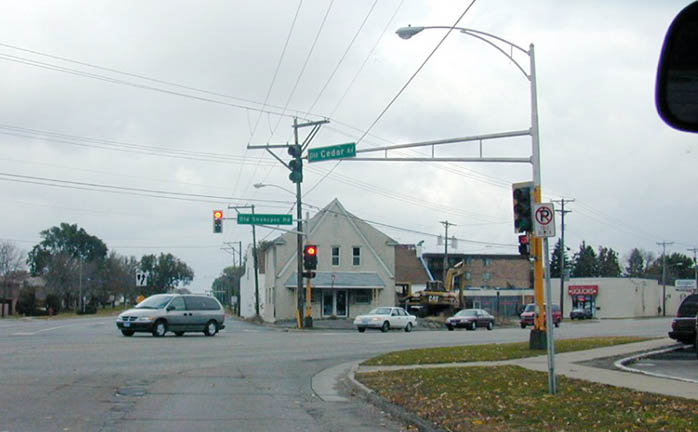
October 2002 Photo taken by Dale Johnson
THE CAT IS GONE
It appears that the building was vacated in about 2000, and demolished in 2002. In its place at the busy intersection is a turn lane from Old Shakopee Road onto Old Cedar Ave. – where the white car is below.
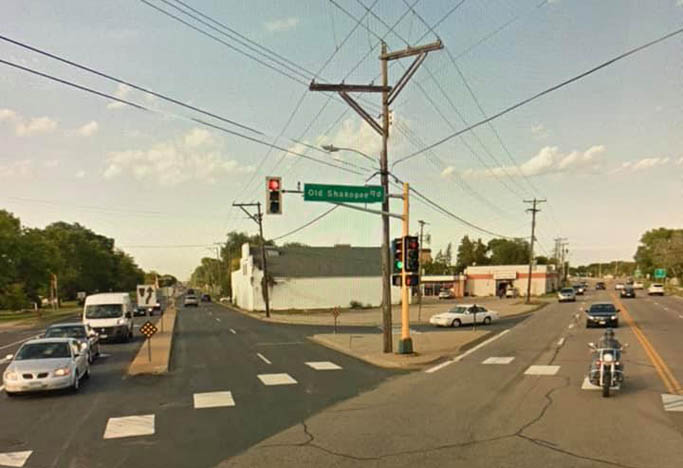
Photo posted on Facebook by Blake Madsden
